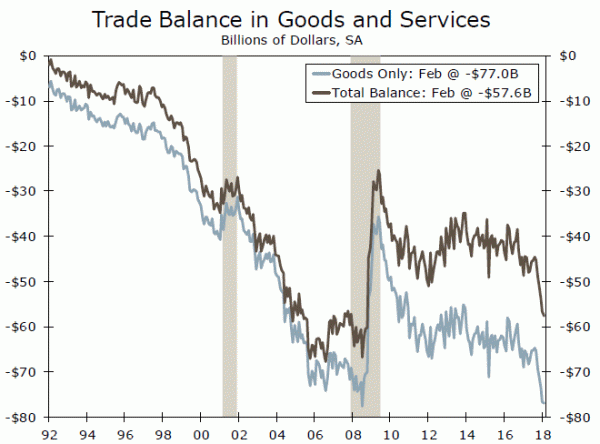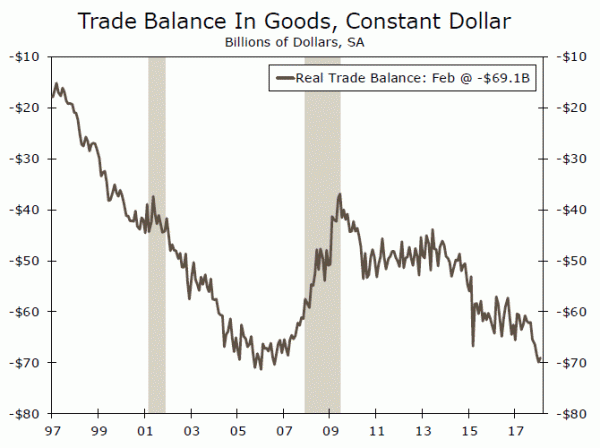The U.S. trade deficit rose to yet another post-Great Recession high in February. It probably will widen even further in coming months.
Exports Rise, But Imports Grow Even More
The U.S. trade deficit widened even further in February, rising to yet another post-Great Recession high of $57.6 billion (top chart). The trade gap was higher than most analysts had expected. Although exports of goods and services were up by $3.5 billion during the month, imports jumped even more, rising by $4.4 billion.
The increase in exports in February may reflect, at least in part, some statistical payback for the sizeable decline that occurred during the previous month. Drilling down into individual categories shows that there generally was broad-based strength in exports in February, with gains in industrial supplies and materials ($2.0 billion), capital goods ($658 million) and autos ($925 million). Exports of consumer goods fell by $840 million in February, but this seems to be more of a one-month outlier rather than a general trend. Indeed, with economic growth remaining solid in the rest of the world and with the trade-weighted value of the dollar down about 9 percent from its high in late 2016, U.S. export growth should remain resilient in coming months.
There was broad-based strength on the import side of the ledger as well. Higher prices of oil led to a modest increase ($256 million) in imports of petroleum products in February. But most of the increase in total imports reflects gains in non-petroleum products (middle chart). Solid growth in U.S. domestic demand in recent months continues to pull in imports, and we expect this dynamic to remain intact in coming months as well. We wrote at the beginning of the year that the trade deficit likely will continue to widen, and we stand by that prognostication.
Net exports exerted a 1.2 percentage point drag on GDP growth in the fourth quarter of 2017, and it appears that the foreign sector continued to exert headwinds on U.S. GDP growth in the first quarter. Not only has the nominal trade deficit widened in recent months, but so too has the real trade deficit, which matters for real GDP growth (bottom chart). If the volume of exports and the volume of imports remained unchanged in March, then real net exports will exert a drag on real GDP growth that would be equal to ¾ of a percentage point.
We wrote above that exports and imports should continue to trend higher in coming months. A potential fly in that ointment would be tariffs that the United States and China have threatened to levy on each other’s products in coming months. A full-blown trade war between the world’s two largest economies, should one develop, probably would not cause American exports and imports to go into reverse, but it could weaken growth in trade. We have written a number of reports in recent weeks on the escalating trade tensions between the United States and China, and we refer interested readers to our website where these reports are posted.















